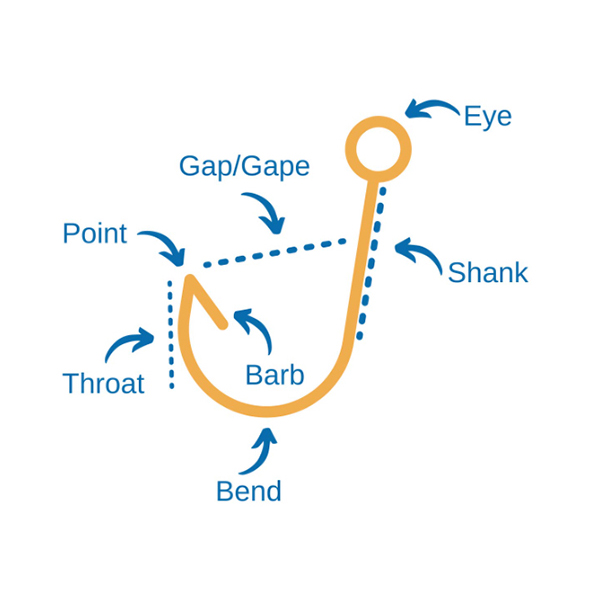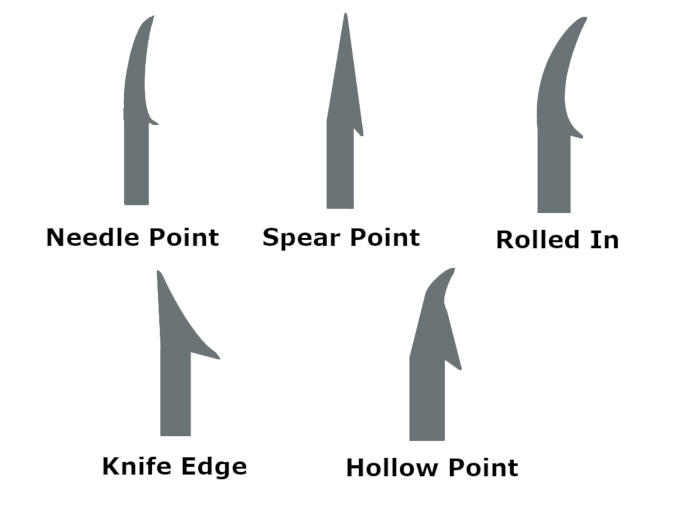1.What is a fishing hook called?
A fish hook or fishhook is a tool for catching fish either by impaling them in the mouth or, more rarely, by snagging the body of the fish.
Every part of a fishing hook has a name. This helps people describe what makes a hook special, and what to use it for. Here’s a short breakdown of each one:
● Eye: The ring that attaches the hook to a lure or a line.
● Shank: The same as the throat, but on the blunt end.
● Bend: Where the hook curves back on itself.
● Throat: The section of the hook running down from the point.
● Barb: A backwards-facing spike that stops the hook from coming loose.
● Point: The sharp bit that pierces the fish’s mouth.
● Gap/Gape: The distance between the throat and the shank.

Out of all these parts, the ones with the most specific varieties are the point and the eye.
1)Types of Hook Point
This is the business end of your whole setup. It’s the difference between a solid hookup and a near-miss. The five most common points are as follows.
● Needle point: Needle points taper in slightly towards the shank. They’re designed to pierce easily, and to cause minimal damage once they’re through. This keeps the hole small, reducing the harm to the fish and making it harder for it to throw the hook.
● Spear point: This is the most common point and a great all-rounder. Spear points run straight up from the throat, giving you decent penetration and limited damage to the fish. They’re also easier to sharpen than more elaborate varieties.
● Rolled in point: Rolled in points pierce deeply with the minimal amount of pressure. The tip faces towards the hook eye, keeping your force directly in line with its path through a fish’s mouth. They’re perfect for fish that thrash about when they’re brought to the boat.
● Hollow point: Hollow point hooks have a bent-in spike which curves down to the barb. They cut through soft-mouthed fish and stay in place once they’re there. However, they can make setting the hook much more difficult on tougher species.
● Knife edge point: Sharpened on both sides and pointed away from the shank, they’re made for maximum penetration. The problem with knife edge points is that they cause a lot of damage to the fish.

2)Types of Hook Eye
The most common is a simple ringed eye. It’s easy to thread line through and works with a variety of knots. For bigger fish, anglers normally use a brazed eye – a loop sealed shut with melted metal. Brazing a hook stops it bending or breaking during the fight. Finally, needle eye hooks are ideal for fishing with bait. You can thread the entire hook through the bait fish easily, just like a sewing needle.
There are also a couple of eyes that you’ll only use with specific fishing techniques. Dry fly anglers swear by a tapered eye, which is more slender towards the end of the loop. This keeps the weight down, helping the fly float properly. On the other end of the scale, a looped eye gives wet flies a little more weight. It also lets fly tyers get more creative with their designs.

2.Types of Fishing Hooks

1)Bait Hook
As bait comes in various sizes and lengths there are also many different styles of bait hooks. Bait hooks often have additional barbs on the shank of the hook as well as the bend area. These additional barbs help to keep the bait on the hook (e.g. squirming worm).

2)Treble Hook
“Treble” meaning consisting of 3 hooks (parts), aka. 3 bends and points to it. These 3 hooks provide excellent bite coverage for fishing artificial lures like crankbaits, spinners, topwater, and even for attaching baits (e.g. trolling for Salmon, Trout, Musky, etc). The Treble hook is very dynamic and effective in keeping the fish on as there can often be more than one hook in the fishes mouth.

3)Circle Hook
It’s a circular shaped hook with a sharp tip. The shape often ensures that the hook point will only hook onto an exposed surface, which is typically in the corner of the fishes mouth. The fish will often hook themselves so you typically don’t need much (or any) of a hook set. Another pro on the circle hook is that it often doesn’t get swallowed by the fish which greatly increases the mortality rate.

4)Octopus Hook
They have a short shank with a slightly lower section wider gap than the average bait hook or J-hook. However, their gap width should not to be confused with the wide gap hooks. The eye points away from the hook point, this makes it ideal for tying egg loop knots which are great for holding yarn, bait, etc. I use these hooks for a variety of species typically with smaller mouths, e.g. Salmon, Steelhead and Trout.

5)Siwash Hook
These long shank hooks are an excellent alternative to treble hooks for various fishing lures (e.g. spinners, spoons, etc). These replacement hooks may be mandatory for specific bodies of water that do no allow more than 1 hook (always check your regulations). One of the biggest pros of the Siwash hook is the lack of snags in heavier foliage water as your only dealing with 1 hook versus 3. Another pro is reduced risk and damage to the fish as you’re only pulling out 1 hook (especially around the gill area reduces mortality rates). Along with less risk to the fish there is also less risk to yourself, as treble hooks can also easily get caught on yourself when they’re being pulling or dealing with the fish.

6)Worm Hook
There are so many options when it comes to worm hooks; weighted, wide gap, extra wide gap, different eyes, etc. I use these most often when fishing for larger mouth species like Bass and use for plastic bait setups, e.g. Texas rig. Worm hooks in general have a wider gap which provides clearance between the eye and hook point so it can hold these large plastic worms, tubes, senkos, creatures, etc.

7)Jig Hook
These jig hooks are used to make weighted jighead hooks (see hook diagram Round Jighead, Shaky Worm Jighead, etc). Jig molds are used for these added weight components to the jig hooks, which often will come in many different weights that are often detailed in ounces (e.g. 1/4 oz 1/2 oz, 3/4 oz, etc). The jig hook is foundational for so many different lure options you see on tackle shelves today.
3.Fishing Hook Sizes
Hook sizes start out at 1 and 1/0. The sizes followed by a zero, are pronounced ‘aughts’.
Sizes with a ‘/0’ after them increase in size as the number increases, while sizes without a zero after them decrease in size as the number goes up.
So, for example, a size 3/0 is larger than a 2/0, which itself is larger than a size 1/0. A size 3 hook is smaller than a size 2, which is smaller than a size 1.

4.How do you know if a hook is good?
A good hook should be strong, tough and sharp.
1)Quality and dull resistant pointed tip: this can eliminate the need for frequent sharpening.
2)Strong yet flexible: to allow the hook to give enough to prevent breaking or tearing out of the fish’s mouth.
5.How can you tell if a hook is sharp enough?
There is an easy way to determine if a hook is sharp.Gently draw the point of the hook across a fingernail.If the point digs in and leaves a mark, it's sharp. If the hook doesn't leave a mark or won't dig in, it needs to be sharpened.
6.How do I choose a hook?
1) The most important characteristic of a fish hook is its size. If a hook is too big, a smaller fish won't be able to get it in its mouth. You'll feel it strike but more than likely only end up with a hook stripped of its bait. If a hook is too small, a larger fish might swallow it entirely. So, hook size should always be matching the size of your bait whenever possible.However, smaller hooks are easier to set, affected less by current, can cast farther, and you can catch small or large fish. It is advisable to pick a hook that will easily pop into a fish’s mouth, specific to the species you are fishing for.
2) To select a quality fishing hook, you need to pay attention to 3 points.
(1) Hook Point And Barb
The hook point must be moderately curved and sharp because it acts to puncture the fish mouth. Moderate angle means that there must be a vertical or slightly inward bend along the hook, and the curvature should not be too large, and the hook point is sharp and tapered. Sharp parts should not be too long, long and easy to break; not too short. It is too short and blunt; the angle of camber should not be too large, and the tip of the hook pierces the fish mouth with a certain angle of inclination, ranging from 30 to 60 degrees. Barbs are suitable for the length of the hook. Because the barb is long, the fish is not easy to unhook, but if it is too long, it is not convenient to take the hook.
(2) Hook Coating
Check the surface of the hook coating, usually black, silver, brown three colors, no matter which color, to be bright, smooth hook body, no uneven.
(3) Strength And Toughness
The choice of the hook is both strong and flexible, which is the main feature of the quality of the hook. Therefore, check the strength and toughness of the hook when purchasing, without machine testing, reliable eyesight and hand or vise. The method is: first look carefully at the hook bend, the hook handle is uniform in thickness, smooth and round, without burrs, injuries, bumps or cracks, and then use the thumb and forefinger to bend and hook the hookup and down and left and right. If you have no problems, you can try to pull. Small and medium-sized hooks are thinner, the pulling force is relatively small, and the fingers can be twisted. Observe whether the hook tip or the hook door is deformed. If it is deformed, the hook is not strong enough and the endurance is small; if it is not moved, or slightly moved, indicating good quality and high endurance.
Post time: Jun-08-2022


